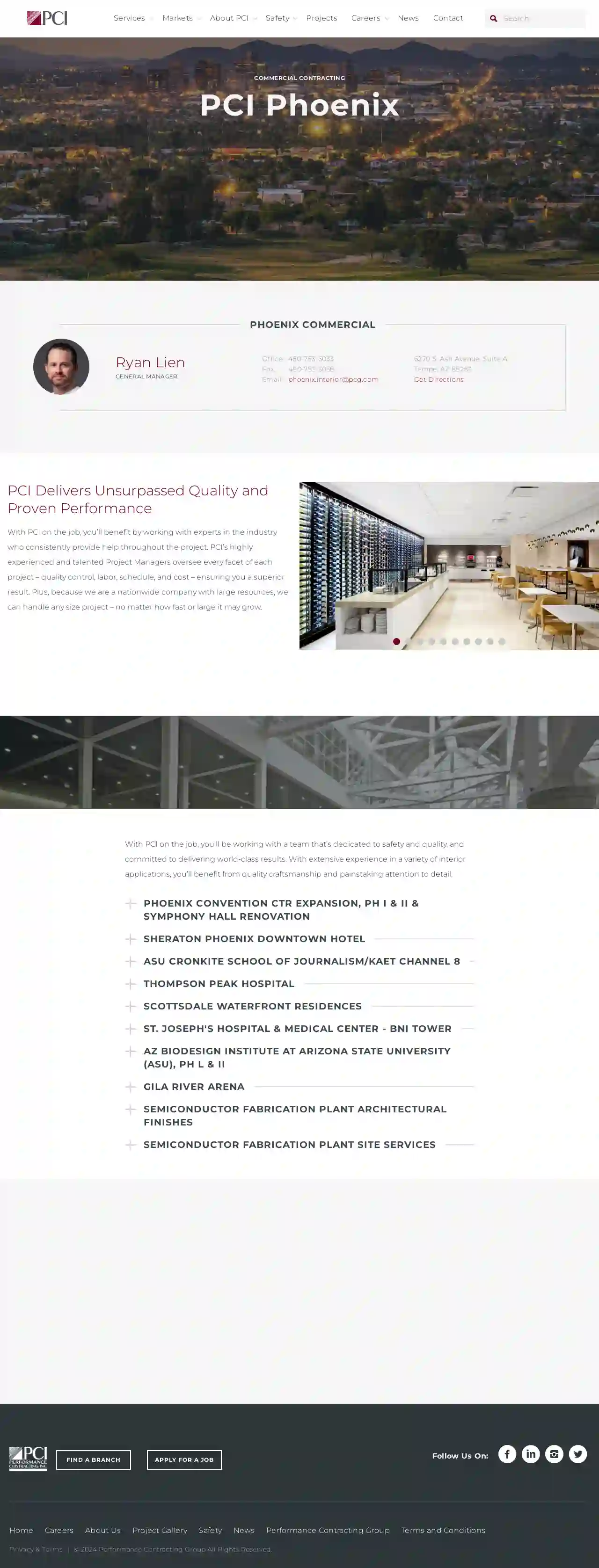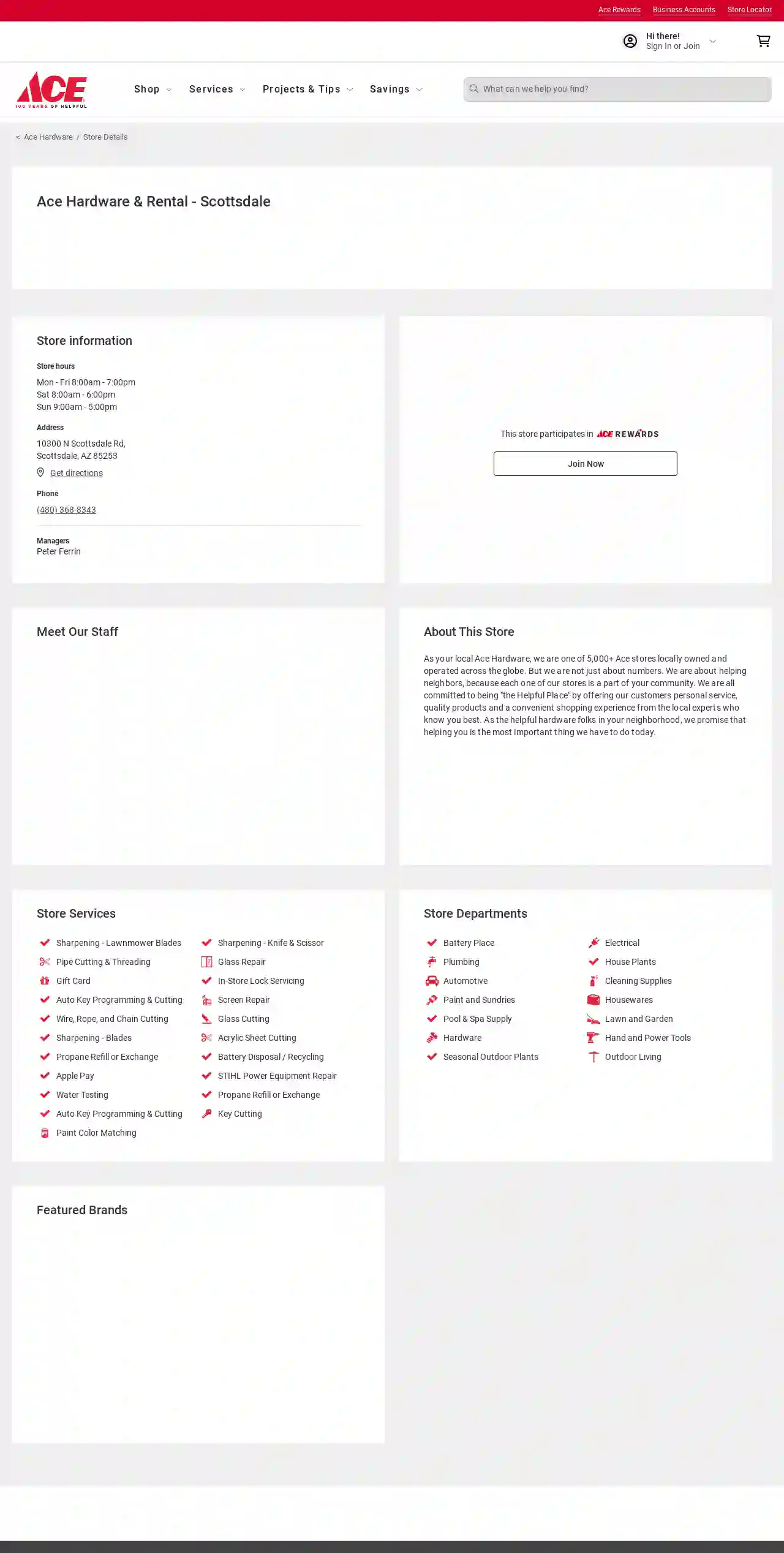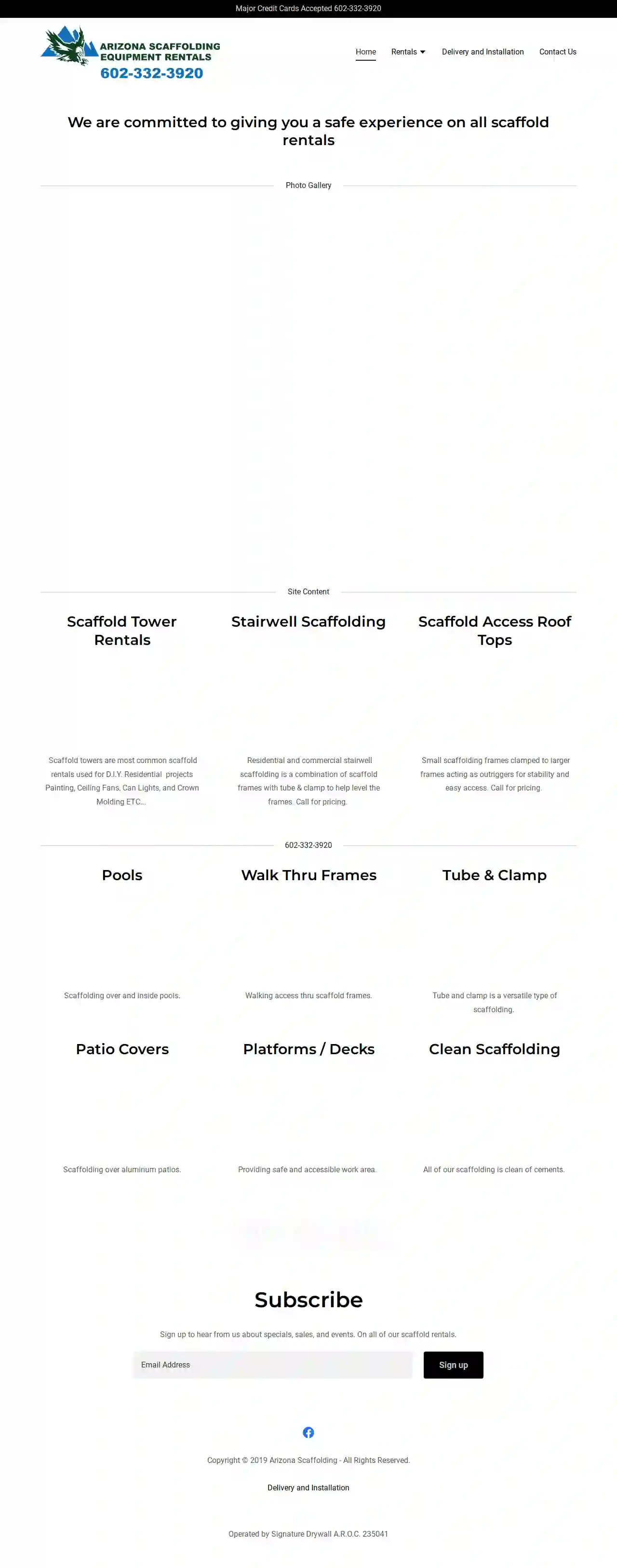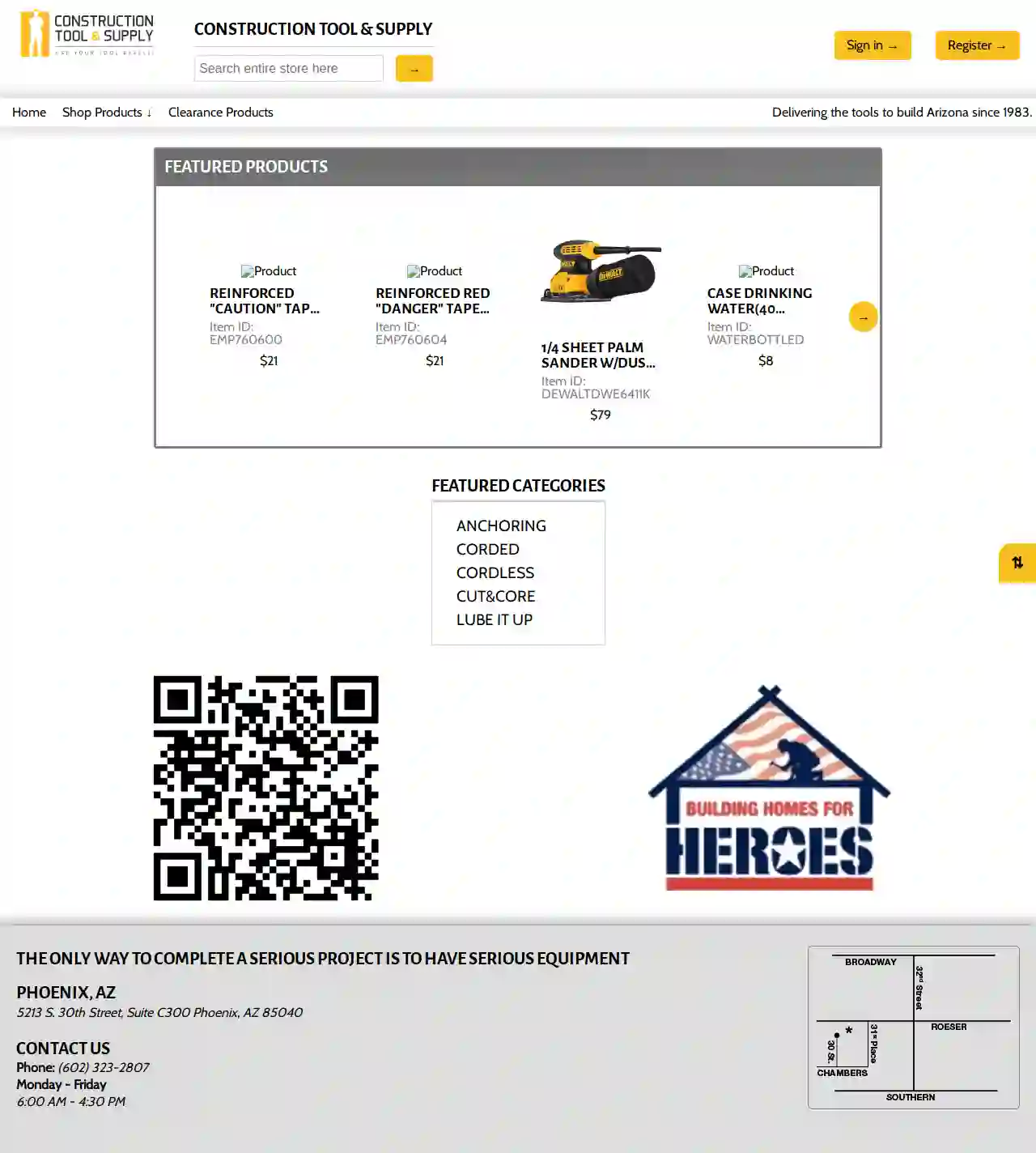Scaffolding Rental New Kingman-Butler
Top 10 Scaffolding Rental in New Kingman-Butler
Get up to 3 Affordable Scaffolding Rental quotes for your project today! Compare profiles, reviews, accreditations, portfolio, etc... and choose the best service.

Performance Contracting Inc
419 reviewsTempe, AZ, 6270 S. Ash Avenue, Suite A, Phoenix, 85283, USPerformance Contracting, Inc. is a top-tier specialty contractor in the United States, providing exceptional services and products to industrial, commercial, and non-residential sectors. With a wide range of related services, PCI establishes itself as a true 'one-stop-shop' contractor, ensuring customers receive comprehensive solutions tailored to their specific needs.
- Services
- Why Us?
- Accreditations
- Our Team
- Testimonials
- Gallery
Get Quote
Ace Hardware & Rental - Scottsdale
4.4227 reviews10300 N Scottsdale Rd, Scottsdale, 85253, USAt Ace Hardware, we're more than just a hardware store. We're your local experts, committed to helping neighbors like you with quality products, personal service, and a convenient shopping experience. As one of over 5,000 Ace stores globally, we're proud to be a part of your community. Our mission is to be 'the Helpful Place' by offering expert advice, a wide selection of products, and a commitment to customer satisfaction. Whether you're a homeowner, DIY enthusiast, or contractor, we're here to help you get the job done right.
- Services
- Why Us?
- Our Team
- Gallery
Get Quote
Arizona Scaffolding
47 reviews3087 E Pecos Rd, Phoenix, 85048, USArizona Scaffolding is a leading provider of safe and accessible scaffolding solutions for residential and commercial projects. With a commitment to safety and customer satisfaction, they offer a range of services including scaffold tower rentals, stairwell scaffolding, and access to roof tops. Their team is dedicated to providing clean and well-maintained scaffolding equipment, ensuring a hassle-free experience for clients. Arizona Scaffolding serves various cities and offers delivery and installation services for all their products.
- Services
- Why Us?
- Accreditations
- Gallery
Get Quote
Sunbelt Rentals
4.271 reviewsTucson, USSunbelt Rentals: Your One-Stop Shop for Equipment Rentals Sunbelt Rentals is a leading provider of equipment rentals in the United States and Canada. We offer a wide variety of equipment for rent, including aerial work platforms, scaffolding, ladders, cranes, boom trucks, scissor lifts, low-level access, manlifts, and more. Whether you're a homeowner tackling a DIY project or a contractor working on a large-scale construction project, Sunbelt Rentals has the equipment you need to get the job done right. We're committed to providing our customers with the best possible experience. That's why we offer a wide range of services, including: 24/7 customer support Fast and reliable delivery Competitive pricing Expert technical support We also have a team of experienced professionals who can help you choose the right equipment for your needs. Contact us today to learn more about our services and how we can help you succeed.
- Services
- Why Us?
- Gallery
Get Quote
Vault Scaffold
43 reviewsMaryland, USWelcome to Vault Scaffold Vault Scaffold is proud to offer the finest Scaffolding in the World, UpRight Scaffold. Don’t settle for less: UpRight Scaffold is the Original, is the safest and utilizes the finest Irish Craftsmanship in every piece made. Still the world innovator in Aluminum Scaffold, Vault Scaffold with UpRight Scaffold is the Choice of CFO’s, CEO’s, Safety managers and front line workers for its light weight, ease of use, safety features and for its 70 year track record of providing the safest Aluminum Scaffold in the world. We have multiple warehouses to ship from, so your order arrives quickly, and most orders ship within 24 hours. Parts order usually ship the same day. Original Upright Parts or Original Vault parts, we have the stock for your field repair needs. Custom designs are not a problem as we offer design and engineering solutions to all of your high reach tower needs. Call us today to discuss your needs.
- Services
- Why Us?
- Gallery
Get Quote
JT Thorpe
511 reviews1060 Hensley Street, Richmond, 94801, USJT THORPE is your trusted partner for comprehensive solutions in refractory, scaffolding, fireproofing, insulation, and more. With over 100 years of industry experience, we deliver exceptional results with unmatched expertise and commitment to quality. Experience the JT THORPE difference: 100+ years of proven expertise in softcraft solutions, combined with cutting-edge technology and unwavering commitment to safety, quality, and reliability.
- Services
- Why Us?
- Gallery
Get Quote
Farwest Insulation Contracting
4.85 reviewsAnaheim, CA, 1220 S. Sherman St., 92805, USFarwest Insulation Contracting is a privately held family business specializing in Commercial & Industrial Mechanical Insulation, Scaffolding, Painting & Industrial Coatings, Firestopping, Asbestos Abatement, and Electric Heat Tracing. The company was incorporated on September 11, 2003, and began operations on December 17, 2004 after acquiring the operating assets of Thorpe Insulation Company. Thorpe Insulation was founded in 1948 in Southern California and quickly established itself as the premier insulation contractor on the West Coast. Today, the company employs more than 300 employees across the Southwestern United States.
- Services
- Why Us?
- Accreditations
- Our Team
- Testimonials
- Gallery
Get Quote
Construction Tool & Supply
564 reviews123 Main Street, Phoenix, 85001, USAbout Construction Tool AZ Construction Tool AZ is your one-stop shop for all your construction tool needs. We offer a wide selection of high-quality tools from top brands at competitive prices. Our knowledgeable staff is always available to help you find the right tools for your project. We are committed to providing our customers with the best possible service and support. We are a family-owned and operated business with over 10 years of experience in the construction industry. We understand the importance of having the right tools for the job, and we are dedicated to helping our customers succeed. We offer a variety of services to meet your needs, including tool rental, tool repair, and tool sales. We also offer free delivery and pick-up services for our customers in the Phoenix area. We are committed to providing our customers with the best possible service and support. We are a family-owned and operated business with over 10 years of experience in the construction industry. We understand the importance of having the right tools for the job, and we are dedicated to helping our customers succeed.
- Services
- Why Us?
Get Quote
SDB Contracting Services
4.431 reviews123 Main St, Anytown, USA, 12345, USSDB Contracting Services is a solutions-oriented service provider that specializes in crating and rigging services. With a focus on growth and opportunity, the company offers a range of services tailored to meet the needs of its clients. From general to specialized services, SDB ensures that all projects are completed with precision and professionalism. The company's mission is to provide top-notch solutions that enhance the quality of life for its clients and the community.
- Services
- Why Us?
- Accreditations
- Our Team
- Testimonials
- Gallery
Get Quote
BrandSafway Solutions Phoenix – Scaffolding, Access & Industrial Solutions
510 reviews1234 Industrial Blvd, Phoenix, 85001, USBrandSafway is a leading provider of access solutions, including scaffolding, aerial work platforms, and forming and shoring equipment. With a strong commitment to safety, quality, and customer satisfaction, BrandSafway offers a wide range of services tailored to meet the unique needs of clients across various industries. Their team of experienced professionals is dedicated to delivering innovative solutions that enhance efficiency and productivity, ensuring successful project outcomes.
- Services
- Why Us?
- Accreditations
- Our Team
- Testimonials
Get Quote
Over 2,353+ Scaffolding Businesses on our platform
Our scaffolding experts operate in New Kingman-Butler and surroundings!
ScaffoldingHQ has curated and vetted the Best Scaffolding Contractors in New Kingman-Butler. Find a top & trustworthy contractor today.
Frequently Asked Questions About Scaffolding Rental
- Save Time: Easily compare quotes from multiple reputable scaffolding rental companies in one place.
- Find Local Providers: Quickly locate scaffolding companies serving your area.
- Get Competitive Rates: Access a network of rental providers, allowing you to compare prices and find the best deal.
- Ensure Safety and Quality: We partner with companies that prioritize safety and adhere to industry standards.
- Access Expert Support: Our customer support team is here to assist you throughout the rental process.
- If the Rental Company Handles Erection/Dismantling: Ensure they are licensed and insured to perform this work.
- If You Hire a Separate Contractor: Verify their qualifications and insurance. The scaffolding company might have recommendations for reputable erectors.
- Base Plates and Adjusters: Use adjustable base plates to level the scaffolding legs on uneven surfaces.
- Ground Preparation: Level the ground as much as possible before erection.
- Bracing and Support: Additional bracing and support may be necessary to compensate for uneven ground conditions.
- Professional Assessment: A qualified scaffolding erector should assess the ground and determine the appropriate measures for safe erection.
Can I modify or alter the scaffolding after it's erected?
What are the benefits of using a scaffolding directory like ScaffoldingHQ?
Who is responsible for erecting and dismantling the scaffolding?
Can I use scaffolding on uneven ground?
Can I modify or alter the scaffolding after it's erected?
What are the benefits of using a scaffolding directory like ScaffoldingHQ?
- Save Time: Easily compare quotes from multiple reputable scaffolding rental companies in one place.
- Find Local Providers: Quickly locate scaffolding companies serving your area.
- Get Competitive Rates: Access a network of rental providers, allowing you to compare prices and find the best deal.
- Ensure Safety and Quality: We partner with companies that prioritize safety and adhere to industry standards.
- Access Expert Support: Our customer support team is here to assist you throughout the rental process.
Who is responsible for erecting and dismantling the scaffolding?
- If the Rental Company Handles Erection/Dismantling: Ensure they are licensed and insured to perform this work.
- If You Hire a Separate Contractor: Verify their qualifications and insurance. The scaffolding company might have recommendations for reputable erectors.
Can I use scaffolding on uneven ground?
- Base Plates and Adjusters: Use adjustable base plates to level the scaffolding legs on uneven surfaces.
- Ground Preparation: Level the ground as much as possible before erection.
- Bracing and Support: Additional bracing and support may be necessary to compensate for uneven ground conditions.
- Professional Assessment: A qualified scaffolding erector should assess the ground and determine the appropriate measures for safe erection.